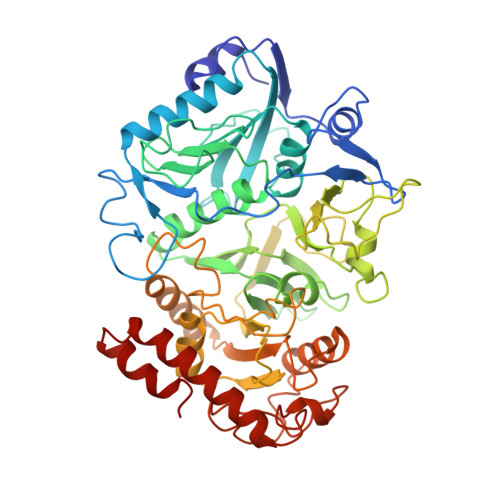The phosphoryl-transfer mechanism of Escherichia coli phosphoenolpyruvate carboxykinase from the use of AlF(3).
Sudom, A.M., Prasad, L., Goldie, H., Delbaere, L.T.(2001) J Mol Biol 314: 83-92
- PubMed: 11724534
- DOI: https://doi.org/10.1006/jmbi.2001.5120
- Primary Citation of Related Structures:
1K3C, 1K3D - PubMed Abstract:
The mechanism of reversible transfer of the gamma-phosphate group of ATP by Escherichia coli phosphoenolpyruvate carboxykinase (PCK) on to its substrate is of great interest. It is known that metallofluorides are accurate analogs of the transition state in the context of kinase mechanisms. Therefore, two complexes of PCK, one with AlF(3), Mg(2+) and ADP (complex I), the other with AlF(3), Mg(2+), ADP and pyruvate (complex II) were crystallized. The X-ray crystal structures of these two complexes were determined at 2.0 A resolution. The Al atom has trigonal bipyramidal geometry that mimics the transition state of phosphoryl transfer. The Al atom is at a distance of 2.8 A and 2.9 A from an oxygen atom of the beta-phosphoryl group of ADP in complex I and II, respectively. A water molecule in complex I and an oxygen atom of the pyruvate in complex II are located along the axis of the trigonal bipyramid on the side opposite to the beta-phosphoryl oxygen with respect to the equatorial plane, suggesting that the complexes are close mimics of the transition state. Along with the presence of positively charged species around the AlF(3) moiety, these results indicate that phosphoryl transfer occurs via a direct displacement mechanism with associative qualities.
Organizational Affiliation:
Department of Biochemistry, University of Saskatchewan, Saskatoon, Canada.


















